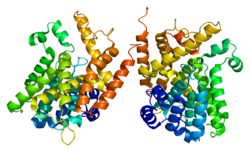Top Qs
Timeline
Chat
Perspective
PDE4B
Protein-coding gene in the species Homo sapiens From Wikipedia, the free encyclopedia
Remove ads
cAMP-specific 3',5'-cyclic phosphodiesterase 4B is an enzyme that in humans is encoded by the PDE4B gene.[5]
This gene is a member of the type IV, cyclic AMP (cAMP)-specific, cyclic nucleotide phosphodiesterase (PDE) family. Cyclic nucleotides are important second messengers that regulate and mediate a number of cellular responses to extracellular signals, such as hormones, light, and neurotransmitters. The cyclic nucleotide phosphodiesterases (PDEs) regulate the cellular concentrations of cyclic nucleotides and thereby play a role in signal transduction. This gene encodes a protein that specifically hydrolyzes cAMP. Alternate transcriptional splice variants, encoding different isoforms, have been characterized.[5][6]
Remove ads
Clinical relevance
Altered activity of this protein has been associated with schizophrenia and bipolar disorder.[5] PDE4B is believed to be the PDE4 subtype involved in the antipsychotic effects of PDE4 inhibitors such as rolipram.[7] PDE4B is involved in dopamine-associated and stress-related behaviours.[8] It has also recently been found to modulate cognition, as reduction in PDE4B activity improves memory and long-term plasticity in mouse models, possibly supporting further therapeutic applications.[9]
Remove ads
Inhibitors
This section needs to be updated. (July 2023) |
Crisaborole, a boron-containing drug was approved by the FDA in 2016 for the treatment of atopic dermatitis, and as of 2024 is being commercialized by Pfizer under the name of Eucrisa (chemical name: 4-[(1-hydroxy-1,3-dihydro-2,1-benzoxaborol-5-yl)oxy]benzonitrile) mainly acting on PDE4B.[10][11][12]
References
Further reading
Wikiwand - on
Seamless Wikipedia browsing. On steroids.
Remove ads








